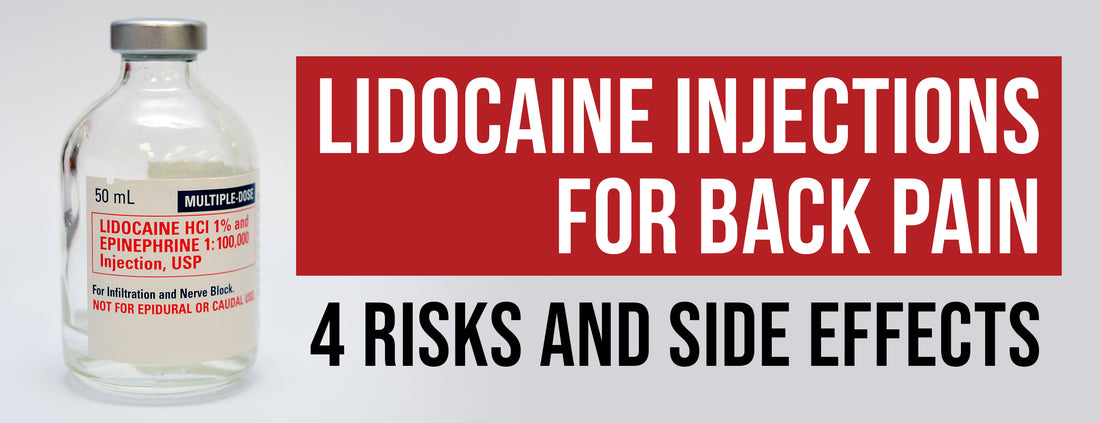Lidocaine (or Xylocaine) is injected into the affected back pain area. Lidocaine is a fast-acting drug, but the effects wear off within about two hours. The purpose of these injections is to provide fast and effective pain relief by blocking the transmission of pain signals to the brain.
While this treatment option may not be suitable for everyone, it has been shown to be effective in managing certain types of back pain, such as herniated discs, spinal stenosis, and sciatica.
In this blog post, explore the fascinating world of lidocaine and discover the truth about its safety and effectiveness as a solution for back pain.
Lidocaine Injections For Back Pain: 4 Risks and Side Effects

Lidocaine injections for back pain can cause allergic reactions, unwanted effects on the cardiovascular and nervous systems, and complications associated with needle insertion. Overdosing can lead to a range of adverse effects. This treatment option must be considered in light of these risks.
Allergic Reactions:
A patient may experience allergic reactions to lidocaine injections, making careful monitoring and immediate medical attention essential.
- Anaphylaxis Risk: Lidocaine injections may rarely trigger severe allergic reactions, such as anaphylaxis, characterized by sudden difficulty breathing, swelling, and a drop in blood pressure.
- Skin and Respiratory Symptoms: Allergic responses might manifest as urticaria (hives), edema (swelling), and bronchospasm (wheezing). Lidocaine injections can occasionally trigger allergic reactions in sensitive people.
- Other Symptoms: Lidocaine injections may occasionally trigger mild allergic reactions, including nausea, vomiting, irregular heart rate or blood pressure, skin flushing, and itching. These symptoms require immediate medical attention if they occur.

Adverse Effects Associated With Overdose:
The use of lidocaine excessively can result in adverse effects, emphasizing the need for precise dosing and medical supervision.
- Depression: Excessive amounts of lidocaine can lead to systemic reactions. Large overdoses of Lidocaine can lead to central nervous system (CNS) depression, potentially causing symptoms like unconsciousness and coma.
- Impact: Overdosing on Lidocaine can result in severe effects on the central nervous system, culminating in states of unconsciousness or prolonged coma.
- Risk: Awareness of the potential for CNS depression underscores the importance of precise dosing and careful administration to mitigate the risk of adverse outcomes.
Cardiovascular And Central Nervous System Effects:

Lidocaine injections can affect the cardiovascular and nervous systems, so a comprehensive process is required. Before the procedure, complete a medical evaluation and understand the patient's health factors.
- Cardiovascular Effects: Although uncommon, potential cardiovascular side effects encompass bradycardia, hypotension, and asystole, warranting careful monitoring during and after lidocaine injections.
- Central Nervous: The central nervous system could experience symptoms such as drowsiness, confusion, or even seizures.
- Central Nervous System Implications: Injections of lidocaine desensitize the nervous system at both the central and peripheral levels. Recent studies have suggested the association between chronic pain and inflammation. Monitoring patients during and after injections, particularly those with pre-existing conditions.

Potential Complications Associated With Needle Insertion:
Lidocaine injection can result in complications, highlighting the need for meticulous technique and skilled healthcare practitioners.
- Infection Risk: While rare, improper needle insertion might introduce infection into the injection site, emphasizing the importance of sterile techniques.
- Bleeding: Needle insertion may cause minor bleeding or bruising around the injection site.
- Nerve Irritation: Accidental contact with nerves during insertion can lead to temporary irritation and discomfort. During lidocaine injections, needle insertion can irritate nearby nerves, leading to temporary discomfort or shooting sensations.
Procedure And Administration For Lidocaine Injections For Back Pain
Lidocaine injections for back pain provide targeted relief through precision and skill. Deep dive into the pain management process to better understand its nuances.
The Injection Process:

Lidocaine injection for back pain involves targeting specific areas afflicted by conditions such as herniated discs and spinal stenosis.
- Preparation: Before the procedure, a healthcare provider will review your medical history and discuss the injection's benefits and potential risks.
- Site Marking: The injection site is typically marked and cleaned for precise administration.
- Anesthetic Application: A local anesthetic may numb the area, reducing discomfort during the injection.
- Lidocaine Injection: The lidocaine injection is carefully administered into the targeted area to relieve localized pain.
- Monitoring: After the injection, you may be monitored briefly for immediate adverse reactions.
Possible Side Effects:
A few side effects are associated with lidocaine injections, including temporary numbness, localized tenderness, or rare allergic reactions. Talk to your doctor about these side effects.
- Common Reactions: Mild soreness or bruising at the injection site is common and usually subside within a few days.
- Rare Complications: While rare, potential side effects may include infection, allergic reactions, or nerve injury. If you experience any unusual symptoms, consult a healthcare professional.
Recovery Period:

An injection often results in a brief recovery period, during which mild soreness or discomfort can be experienced. The short-term reaction should gradually subside so the procedure is effective overall.
- Immediate Post-Injection: You might experience temporary relief due to the numbing effects of the lidocaine.
- Follow-Up: Follow any specific post-injection instructions provided by your healthcare provider.
- Long-Term Relief: The full effects of the lidocaine injection may become evident as the numbing agent wears off and the anti-inflammatory properties take effect.
Comparison With Other Treatment Options
Comparing lidocaine injections with surgical and non-surgical back pain interventions can reveal the benefits and drawbacks. Making an informed decision requires understanding these differences.
Surgery:
Surgery is usually reserved for severe cases that have failed conservative treatments. It involves more substantial risks and recovery time compared to lidocaine injections.
- Surgery may be more effective for specific types of back pain, such as disc herniation.
- Surgical procedures require anesthesia and take a long time to recover from.
- It can be effective for certain conditions, such as herniated discs or spinal stenosis.
- Risks include infection, nerve damage, and failure to alleviate pain.

Non-Surgical Interventions:
Patients can achieve targeted relief with lidocaine injections without lengthy recovery periods. Lidocaine injections can also be combined with non-surgical interventions like physical therapy.
- Non-surgical options for back pain include physical therapy, chiropractic care, and acupuncture.
- Non-surgical interventions help manage pain and prevent future back problems.
- It may take longer to see results and require ongoing maintenance.
Back Pain Conditions That May Require Lidocaine Injections
Lidocaine injections are a common treatment option for those suffering from back pain caused by various conditions. A lidocaine injection may be needed for herniated discs, spinal stenosis, or sciatica.
Herniated Discs:
Herniated discs, which involve the displacement of spinal disc material, can lead to nerve compression and severe back pain. Lidocaine injections can relieve targeted pain by numbing the affected area and reducing nerve-related discomfort.
Spinal Stenosis:

Spinal stenosis can cause back pain, leg pain, and weakness because the spinal cord is affected. Occasionally, spinal stenosis pain can be treated with lidocaine injections, especially if other treatments have not worked.
Spinal stenosis is treated with injections into the area surrounding the spinal cord, which reduces inflammation and relieves pain. It typically takes a few minutes to complete the injection, and the effects can last for days.
Sciatica:
Sciatica is called leg pain due to compression of the sciatic nerve. Lidocaine injections can help alleviate this pain by numbing the affected nerve and relieving sciatic discomfort.
Conclusion:
Lidocaine injections can be a viable treatment option for struggling with back pain. While there are some risks associated with the procedure, research has shown that it can effectively reduce pain and improve function.
Discuss the risks and benefits of lidocaine injections with your healthcare provider for back pain. Research lets you determine the best treatment option for your back pain.










![The 7 Factors That Determine Whether You Can Get Lip Injections With Breastmilk [7 Safety Tips]](http://drnumb.com/cdn/shop/articles/Can_You_Get_Lip_Injections_While_Breastfeeding__6_Factors_7_Safety_Tips.jpg?v=1711186573)



